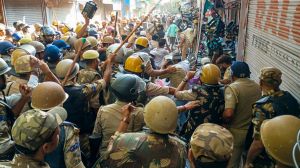Popularity the key, Indian rugby gives
A SLICE of history floated in and out of Calcutta over the past weekend. The grounds of the Calcutta Cricket and Football Club (CC&FC) hoste...

A SLICE of history floated in and out of Calcutta over the past weekend. The grounds of the Calcutta Cricket and Football Club (CC&FC) hosted the country’s first-ever international rugby match. The result, Taiwan drubbing the hosts 61-20 in the 2003 Asian Region IRB Quadrangular Series match, is inconsequential. From being nowhere on the world rugby map, India has taken a first tentative step towards making the game popular in the country.
First up, the numbers: India lost to Singapore 71-0 and then 20-13 to Malaysia in matches played in Singapore. Then, the loss to Chinese Taipei came up in Calcutta.
But Indian Rugby Football Union (IRFU) vice-president Noomi Mehta sees a thick silver lining in these results, calling the match against Malaysia one ‘‘we should have won’’. ‘‘We lost only because of our inexperience and indiscipline. At half time, we were leading 13-0. But we were totally clueless about how to shut off a game. Other countries waste time when in a good lead. We didn’t. It was a mistake.’’
The IRFU, however, prefers to accentuate the positive and dwell on its efforts to spread the game. ‘‘It’s a a three-pronged attack strategy’’, Mehta says. ‘‘The police department, the armed forces and schools: we are trying to convince all three to take to rugby. The Eastern Command Army headquarters in Calcutta have already agreed to it. Once we can touch all the centres, the game would have spread across the country.’’
Indeed, the game has taken root in a way that would have seemed unimagineable a decade ago. Rugby’s popularity began to decline in the 1990s when the game’s traditional core in India, the Anglo-Indian, Armenian and Parsi communities, started dwindling in strength. It needed lateral spread and two NGOs, Future Hope in Kolkata and Magic Bus in Mumbai provided just that by training slum children. They’ve both met with considerable success; Future Hope reached the final of the All India and South Asia rugby meet last August, while Magic Bus went on to win the loser’s plate.
Today, rugby is a more fashionable sport (Rahul Bose’s commitment hasn’t hurt), the polo of the beer-drinking set, the ultimate outlet for male bonding.
As India team captain Chaitanya Sinh says, ‘‘We have started getting a fair amount of international rugby. Of course it’s not enough. Other teams are exposed to a lot more international rugby. But we are getting more visibility. The number of clubs have increased. Things are looking brighter.’’
And when exactly should we expect India to start doing well in international meets? ‘‘I would put it at around 3-4 years if our three-pronged plan works out. If not, maybe another 15 years. Also, we need funds to tour abroad and build our infrastructure. But unless we show the numbers, the money won’t start coming in.’’
Unlike popular perception, there is room for all shapes and sizes in a rugby line-up. Mehta says, ‘‘You need men with pot-bellies as well as the tall, lanky ones, speedy ones, light ones and those with good reflexes.’’ Surely, India has a good assortment of all the varieties. And with part of the script requiring a nice Asterix-like punch-up, a lot of Indian communities would love to have a go if they knew how.





- 01
- 02
- 03
- 04
- 05


























